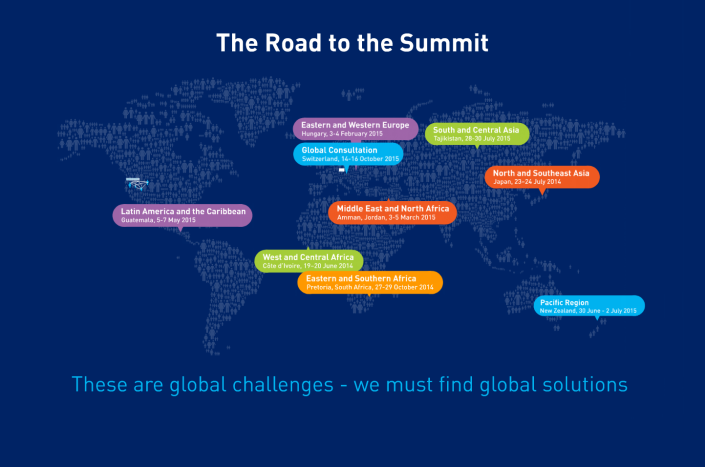Innovation
8. Prepositioning Relationships and Technology to Better Communicate with Communities in Disaster Response
Panelists: Ms. Angela Rouse, Senior Programme Manager, CDAC Network Secretariat; Mr. Mike Adams, International Coordinator, First Response Radio; Mr. Gil Arevalo, Communications with Communities Coordinator, UN Office for the Coordination of Humanitarian Affairs (OCHA)
Wednesday, 29 April 2015, 11:40-12:20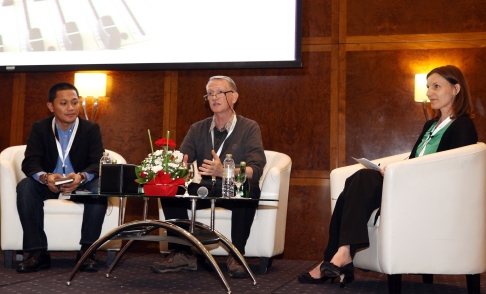
In the days and weeks following a disaster, information and the means to communicate – both with each other and with responders – are crucial for the survival and well-being of communities. They also play a key role in early warning. The humanitarian response system has the know-how and technology to enable this to happen as a matter of course, and yet it persists as a major challenge.
Gil, Mike and Angela discuss the communication needs of communities and what it means for the humanitarian system: looking at how we can address this systemic challenge early and collectively, through partnership across traditional boundaries and with genuine commitment to put people first.
Ms. Angela Rouse, Senior Programme Manager, CDAC Network Secretariat
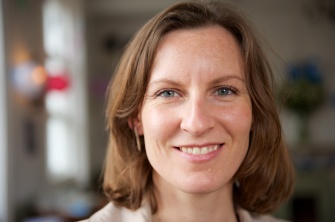 Angela is currently Senior Programme Manager for the Secretariat of the Communicating with Disaster Affected Communities (CDAC) Network. The Network is a unique collaboration between NGOs, UN agencies, media development
Angela is currently Senior Programme Manager for the Secretariat of the Communicating with Disaster Affected Communities (CDAC) Network. The Network is a unique collaboration between NGOs, UN agencies, media development
agencies, technology providers and others that crosses traditional boundaries to leverage improvements both in information sharing for communities, and two-way communication between humanitarian responders and disaster-affected people, as well as between disaster affected people themselves. Angela leads the implementation of the Network’s capacity strengthening work and manages the programme team. “Ultimately I want to see humanitarian responses where community voices truly shape programmes and decisions, and where communities, duty bearers and responders work together to implement the responses.”
Prior to joining the CDAC Network in November 2013, Angela was the Emergency Capacity Building Manager for CARE International and brings rich experience of interagency collaboration across various initiatives, accountability in practice, training design and delivery, and evaluative work. Angela has a strong programmatic background, having spent many years working in the Democratic Republic of Congo, Uganda and Kenya across various sectors, including primary health care, gender-based violence, and water, sanitation and hygiene. She has worked in the humanitarian sector for over ten years, prior to which she worked in scientific research following an education in biology and public health.
Mr. Mike Adams, International Coordinator, First Response Radio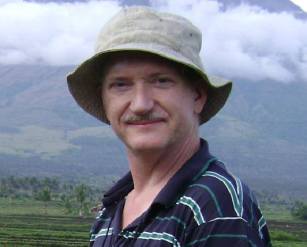
Originally from Seattle, Washington, Mike started his career as an aircraft radio technician. He has worked as a broadcast engineer since 1987 with experience in SW transmitters, antennas, studios and Mike’s favorite – AM radio remote broadcasts. In 2003 he received Society of Broadcast Engineers (SBE) certification as a Professional Broadcast Engineer for 20 years experience in radio.
Mike began working as a consultant with Health Communications Resources (HCR) after the 2004 Asian tsunami where they worked together with a local partner to put an Emergency FM radio station on the air in Indonesia. After seeing the value of radio after a disaster, he has worked to develop the Rapid Response Radio Unit (RRRU) that can be deployed anywhere in the world within 72 hours of a disaster.
The network of participating stations is called FIRST Response Radio and Mike has been serving as the international coordinator since the start. Since 2007, Mike has led Rapid Response Radio Workshops and field trials in the Philippines, India and Indonesia teaching teams to use radio in humanitarian relief for the affected communities following disasters.
A RRRU team was led by Mike into the flooded Kosi river region of Bihar, India in 2008 to establish radio broadcasts to assist the 3 Million people affected by the flood. He also led a team into Sumatra Indonesia following the Sept 2009 Earthquake, establishing an FM station within 5 days of the disaster. Mike most recently took a team into the most affected community in Tacloban, Philippines following typhoon Haiyan/Yolanda where all radio and TV stations were off the air. The team arrived on the 5th day and were broadcasting on the 6th day after the powerful typhoon.
Mike received a Bachelor of Science in Electrical Engineering (BSEE) from Washington State University in 1984. Mike is married, has two daughters and currently lives in Cambodia.
Mr. Gil Arevalo, Communications with Communities Coordinator, UN OCHA
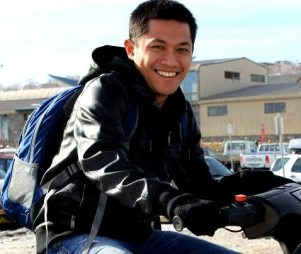 Gil Francis Arevalo has twelve years of experience in the field of media, communication, humanitarian and emergency response, community engagement, youth development, disaster risk reduction and management and climate change adaptation. Since 2003, he has worked in different capacities with various organizations like the Philippine Daily Inquirer, Save the Children-US, YMCA-Japan, Oxfam-GB, UNFPA and UNDP.
Gil Francis Arevalo has twelve years of experience in the field of media, communication, humanitarian and emergency response, community engagement, youth development, disaster risk reduction and management and climate change adaptation. Since 2003, he has worked in different capacities with various organizations like the Philippine Daily Inquirer, Save the Children-US, YMCA-Japan, Oxfam-GB, UNFPA and UNDP.
Currently, he is with the United Nations Office for the Coordination of Humanitarian Affairs (OCHA) – Philippines as Communications with Communities (CwC)/Accountability to Affected Populations (AAP) Coordinator, establishing and leading a CwC/AAP preparedness working group at the national level, which is designated to facilitate coordination for communications with disaster-affected communities practitioners in partnership with the Government of the Philippines, CSOs, INGOs, media, private sectors, telecommunication companies, and faith-based groups.
He provided proper coordination through the Community of Practice of CwC/AAP and technical support during successive emergencies and disasters in 2013: Zamboanga armed conflict, Bohol earthquake, and typhoon Haiyan; and also as part of preparedness initiative during typhoon Hagupit in 2014 and typhoon Maysak in 2015.
Links to related material:
The CDAC Network
First Response Radio
First Response Radio Tacloban Deployment
UN Office for the Coordination of Humanitarian Affairs – Philippines
9. Multi-Channel Mobile Crisis Response Platforms: Lessons Learned in the Middle East
Presenter: Mr. Yazeed Sheqem, Director of Business Development, MENA & Africa, Souktel Inc.
Wednesday, 29 April 2015, 13:50-14:20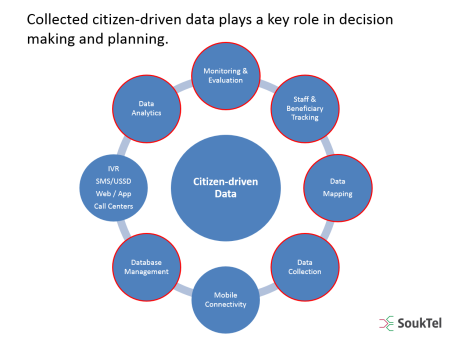
When humanitarian disaster strikes, rapid response–at scale—is crucial to saving lives and minimizing damage. But in many crisis zones, a shortage of ex-ante population data means that aid providers often lack a clear understanding of local demographics. As a result, NGOs and aid agencies fail to develop effective communication and outreach strategies, and communities fail to receive critical life-saving information.
Multi-channel mobile platforms help address this challenge—by providing a range of simultaneous options for transmitting information to and from disaster-affected populations. Yazeed Sheqem spoke about lessons that Souktel, based in Ramallah, Palestine, has learned in the Middle East.
Mr. Yazeed Sheqem, Director of Business Development, MENA & Africa, Souktel Inc.
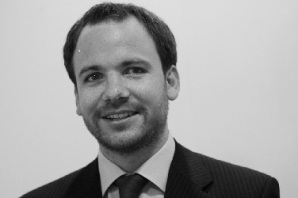 Yazeed Sheqem leads Souktel’s strategic outreach to clients and partners in the Levant, Gulf, North Africa and Sub-Saharan African regions. He also drives Souktel’s consulting practice which advises clients in the fields of ICT4D and M4D. Yazeed has extensive experience in the area of technology utilization for disaster and emergency response as well as economic growth and employment.
Yazeed Sheqem leads Souktel’s strategic outreach to clients and partners in the Levant, Gulf, North Africa and Sub-Saharan African regions. He also drives Souktel’s consulting practice which advises clients in the fields of ICT4D and M4D. Yazeed has extensive experience in the area of technology utilization for disaster and emergency response as well as economic growth and employment.
Yazeed holds a Master’s degree in economics from the Goethe University in Frankfurt-Germany as well as a higher degree in urban planning from New York University. He is based in Amman-Jordan and is fluent in Arabic, English, and German.
Founded in 2006, Souktel is a provider of end-to-end technology solutions that support the projects of 30+ development funders and implementers across the globe. Additionally, Souktel delivers strategic consulting services in the fields of ICT4D and M4D. Souktel is mainly engaged in the areas of disaster and emergency response, economic growth and employment, education and youth, as well as democracy and governance. Based in Ramallah-Palestine, Souktel helps change lives in more than 20 emerging markets in Africa, Asia, and the Americas.
Link to related material:
13. Designing Future Solutions, Listening to the Most Important Stakeholder
Presenter: Ms. Abi Weaver, Global Technology Project, American Red Cross
Thursday, 30 April, 09:10-09:40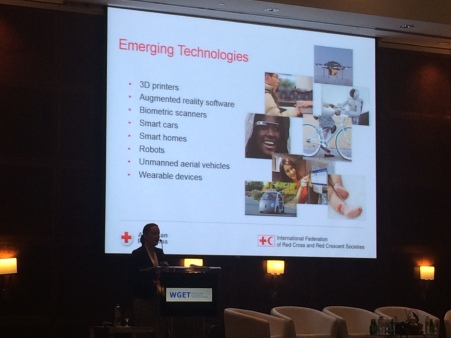
With an eye on the threats and opportunities of the next decade, the Red Cross Red Crescent recently developed a multi-sector vision outlining how emerging technologies can address emerging humanitarian needs. Community engagement was essential to the development of this vision and their diverse ideas drove both the problem sets and solutions.
Abi Weaver shared lessons from her experience helping people on the receiving end of emergency aid identify and voice their own needs directly, improve their knowledge, design their own solutions and expand their coping strategies through technology. She also shared why the Red Cross Red Crescent cares about the design, use and cost of future technology solutions and how this focus is helping them prepare for other global shifts like climate change. And she revealed what they learned from communicating with communities about their emerging needs and barriers as well as their attitudes, beliefs, questions and concerns about emerging technologies.
Ms. Abi Weaver, Global Technology Project, American Red Cross
 Abi Weaver, a director within the international division of the American Red Cross, is currently researching and testing emerging technology solutions with the vision that they can help strengthen disaster resilience in urban communities. In addition to her 10-year career with the Red Cross, Abi has held strategic communications and government relations positions at PATH, an international nonprofit organization that accelerates global health technologies, as well as the National Parent Teacher Association, America’s premiere child advocacy organization.
Abi Weaver, a director within the international division of the American Red Cross, is currently researching and testing emerging technology solutions with the vision that they can help strengthen disaster resilience in urban communities. In addition to her 10-year career with the Red Cross, Abi has held strategic communications and government relations positions at PATH, an international nonprofit organization that accelerates global health technologies, as well as the National Parent Teacher Association, America’s premiere child advocacy organization.
She has earned degrees in journalism and public relations, and lives in the Washington, DC metro area.
Links to related material:
American Red Cross
Global Dialogue on Emerging Technology for Emerging Needs
15. From Typhoon Haiyan to Typhoon Hagupit: Reflections on a Year of Building Data Preparedness and Resilience Networks in the Philippines
Presenters: Mr. Andrew Schroeder, Director of Research and Analysis, Direct Relief; Mr. Justin Richmond, Mission Specialist, Palantir Technologies
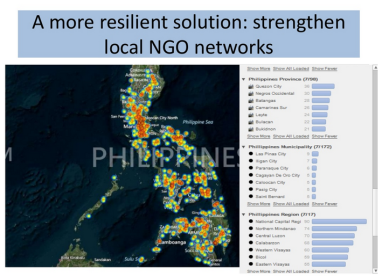 Thursday, 30 April 2015, 11:50-12:20
Thursday, 30 April 2015, 11:50-12:20
The session presented findings from collaborative data preparedness and community resilience work between the milestones of Typhoons Haiyan and Hagupit in the Philippines.
During Typhoon Haiyan, Direct Relief and Palantir partnered on the MIMOSA (MIniature MObile SAtellite) project for real-time collection of needs assessment data via satellite-connected SMS. Data from the community and infrastructure assessments was integrated via the Palantir Gotham software with open data on international response actors via OCHA and the NDRRMC to gain dynamic understanding of where the response was concentrated relative to storm impacts.
In part on the basis of post-Haiyan findings from the MIMOSA data, which indicated significant gaps between the international response and the needs of many communities, Direct Relief teamed up again with Palantir throughout 2014 to expand data-driven resilience activities with local partners, particularly the Filipino voluntary organization Gawad Kalinga. The goals of this activity have been:
- Staging data collection and analysis tools with regional leads through the country,
- Improving network-independent data collection through integration with ODK (Open Data Kits)
- Establishment of viable community and health assessment ontologies
- Creation of data sharing arrangements prior to the onset of new events
As a result of these activities Gawad Kalinga is beginning to collect baseline data from as many as 20,000 barangays and to create new community-level data collection and analysis practices. These new arrangements have already been put to the test during response to Typhoon Hagupit in December 2014, producing a wealth of insight into how we might best help to improve disaster response through flexible, technologically-enabled, locally-driven and internationally supported efforts.
Mr. Andrew Schroeder, Director of Research and Analysis, Direct Relief
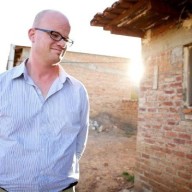 Andrew Schroeder is the Director of Research and Analysis at Direct Relief. He specializes in geographic information systems (GIS) for humanitarian operations and global public health. Andrew and Direct Relief were recognized in 2013 for this work with the President’s award from Esri, and again in 2015 with Esri’s special achievement in GIS award. Andrew is currently engaged in a wide range projects, from the evaluation of global drug donation programs to the use of unmanned aerial vehicles for disaster response to the deployment of GIS tools to track and count community health workers to the implementation of spatial analysis in the national laboratory systems of Ethiopia and Indonesia. He has worked on analytics for disaster relief in crises ranging from Typhoon Haiyan in the Philippines to Hurricane Sandy in New York and the Haiti earthquake. In 2014 he founded the Nethope working group in humanitarian UAVs and joined the advisory board of UAViators. He also serves on the global advisory board to the One-Million Community Health Workers Campaign. Andrew received his PhD from New York University’s Department of Social and Cultural Analysis and his Masters in Public Policy from the Ford School at the University of Michigan.
Andrew Schroeder is the Director of Research and Analysis at Direct Relief. He specializes in geographic information systems (GIS) for humanitarian operations and global public health. Andrew and Direct Relief were recognized in 2013 for this work with the President’s award from Esri, and again in 2015 with Esri’s special achievement in GIS award. Andrew is currently engaged in a wide range projects, from the evaluation of global drug donation programs to the use of unmanned aerial vehicles for disaster response to the deployment of GIS tools to track and count community health workers to the implementation of spatial analysis in the national laboratory systems of Ethiopia and Indonesia. He has worked on analytics for disaster relief in crises ranging from Typhoon Haiyan in the Philippines to Hurricane Sandy in New York and the Haiti earthquake. In 2014 he founded the Nethope working group in humanitarian UAVs and joined the advisory board of UAViators. He also serves on the global advisory board to the One-Million Community Health Workers Campaign. Andrew received his PhD from New York University’s Department of Social and Cultural Analysis and his Masters in Public Policy from the Ford School at the University of Michigan.
Mr. Justin Richmond, Mission Specialist, Palantir Technologies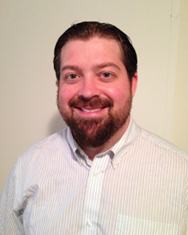
Justin Richmond is currently a forward deployed engineer at Palantir Technologies as well as a Truman National Security Project Fellow. At Palantir, he led the field implementation for the Typhoon Haiyan and Typhoon Hagupit responses in the Philippines. Justin is currently working on data-driven countering violent extremism (CVE) programming in Iraq. He has appeared on BBC World News Service, CCTV’s Cultural Hour, and Radio Sawa speaking on East Asian security issues, North Korea, and nuclear nonproliferation.
Before joining Palantir, Justin deployed to Afghanistan to serve as USAID’s District Stability Framework coordinator to civilian District Support Teams and tactical military units. In that role, he advised and mentored joint civilian/military/Afghan teams on stabilization implementation, and monitoring and evaluation in eastern Afghanistan’s most contested districts.
Justin has worked extensively with local populations in northeastern China, South Korea, and throughout the Philippines. Justin also served in the U.S. Army, first as an Airborne Infantryman and then as a special operations team leader in the southern Philippines in 2009, where he focused on stabilization, counterinsurgency, and information operations. He received his B.A. in Public Policy studies from Duke University in 2005 and is a fluent Korean speaker.
Links to related material:
Direct Relief
Mimosa Project
Palantir Technologies
Palantir Disaster Preparedness
16. World Humanitarian Summit: Defining the Future Humanitarian Response
Presenter: Mr. Matthew Hochbrueckner, Business Partnership Adviser, UN Office for the Coordination of Humanitarian Affairs (OCHA)
Thursday, 30 April 2015, 13:30-14:00
The World Humanitarian Summit, an initiative launched the Secretary-General of the United Nations, is a once in generation opportunity to bring the global community together to commit to new ways of working to save lives and reduce hardship around the globe. The Summit will be held in Istanbul in May 2016, and will be proceeded by numerous consultations including those dedicated to the private sector.
The Summit’s Power of Business theme seeks to engage business actors in discussions on their unique role in emergency preparedness and response by highlighting interests, opportunities and challenges. The ultimate goal is to showcase innovative ways to maximise the power of business in alleviating crises in vulnerable communities and markets. This session highlighted current trends in private sector engagement and addressed identifying opportunities to influence the Summit’s agenda and resulting commitments.
Mr. Matthew Hochbrueckner, Business Partnership Adviser, UN OCHA
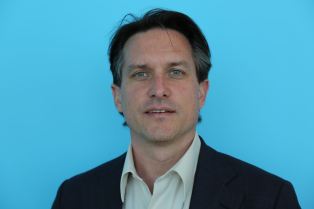 Matt Hochbrueckner is the Business Partnership Adviser for UN OCHA in New York, focusing on building collaborative private sector engagement in emergencies, and facilitating business consultations in the lead up to the World Humanitarian Summit. Most recently he helped lead coordination with the private sector for UNMEER during the Ebola crisis. Matt has worked the last 8 years with OCHA in partnerships, policy, strategic planning and monitoring. He has more than 20 years of experience in relief and development, having served in the Philippines, Sierra Leone and the Balkans. This is his third WGET event.
Matt Hochbrueckner is the Business Partnership Adviser for UN OCHA in New York, focusing on building collaborative private sector engagement in emergencies, and facilitating business consultations in the lead up to the World Humanitarian Summit. Most recently he helped lead coordination with the private sector for UNMEER during the Ebola crisis. Matt has worked the last 8 years with OCHA in partnerships, policy, strategic planning and monitoring. He has more than 20 years of experience in relief and development, having served in the Philippines, Sierra Leone and the Balkans. This is his third WGET event.
Links to related material:
20. Disruptive Innovation: Train Wrecks on the Right Track
Presenter: Mr. Edward G. Happ, Global CIO, International Federation of the Red Cross and Red Crescent Societies (IFRC)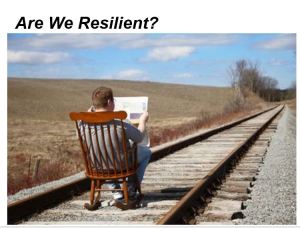
Thursday, 30 April 2015, 16:10-16:40
The late American humorist, Will Rogers, once quipped that “Even if you are on the right track, you’ll get run over if you just sit there.” And yet large parts of our Civil Society Organizations (CSOs) infrastructure is based on last century models—even if only 15 years ago. A recent study by the International Civil Society concluded that “The role CSOs will play in tomorrow’s world may very much depend on their ability to anticipate and effectively navigate disruptions.”
Disruptive change is about scale, speed and surprise; the point being that it is hard to plan for, but imperative to be flexible and agile for. Yet for some of our organizations the large ‘lights-on’ infrastructure has become the tail that wags the dog. Add to that the trends in large systems and it is evident large CSOs are pursuing a corporate IT path that they cannot afford or sustain. Will we be able to move fast enough to avoid the train-wreck?
This session looked at how organizations can adopt and leverage disruptive changes while managing the enterprise during this transformation.
Mr. Edward G. Happ, Global CIO, International Federation of the Red Cross and Red Crescent Societies (IFRC)
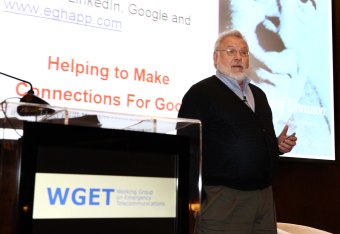 Edward G. Happ is the Global CIO of the International Red Cross and Red Crescent Societies, based in Geneva, Switzerland, and co-founder and former Chairman of NetHope, a U.S. based consortium of 41 leading international relief, development and conservation nonprofits focused on information and communications technology (ICT) and collaboration.
Edward G. Happ is the Global CIO of the International Red Cross and Red Crescent Societies, based in Geneva, Switzerland, and co-founder and former Chairman of NetHope, a U.S. based consortium of 41 leading international relief, development and conservation nonprofits focused on information and communications technology (ICT) and collaboration.
He is the former Chief Information Officer at Save the Children, in Westport, Connecticut. During his first year at Save the Children, in March 2001, he presented a paper to Cisco on “Wiring the Virtual Village,” which became the basis for NetHope. Before joining Save the Children, he was a senior partner and founder of HP Management Decisions Ltd., a management consultancy, and has held a variety of corporate management positions, to the Senior Vice President and General Manager level, with Wall Street data providers, service and software product companies.
His 35 years of professional experience include all facets of managing information services and high technology businesses, including general management with P&L responsibility, operations, product management, sales, marketing, customer service, human resources management, technical consulting, manufacturing, and both software and hardware development.
He began his career as an Assistant VP, Equity Research at the First Boston Corporation. Mr. Happ is a graduate of Drew University where he also did graduate work. He is also the founder and editor of The Fairfield Review, Connecticut’s first on-line literary magazine. Further information on Mr. Happ may be found on his web page at: www.eghapp.com.
Link to related material:
International Federation of the Red Cross and Red Crescent Societies (IFRC)
